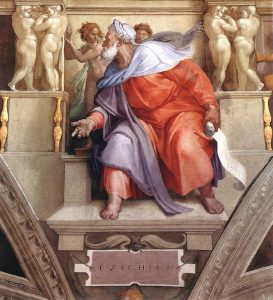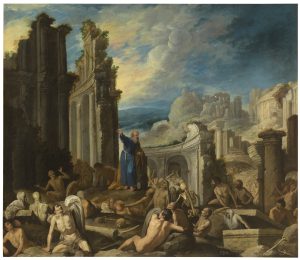Ezekiel was the son of the priest Buzi, and he himself was also a priest. In the year 597 B.C., while still young, he was among the first group of deportees taken to Babylon by Nebuchadnezzar. Five years later, in 593 B.C., upon turning thirty — the age at which he should have begun his priestly functions — he had a vision by the River Chebar, near the Euphrates, which brought about a profound inner transformation. From that moment on, he began an intense prophetic mission which helped greatly to sustain the faith of the deported people in the Lord, the God of Israel.

Prophet Ezekiel by Michelangelo
Ezekiel sheds light on the situation of the exiles using celestial visions, allegories, and grand images that give his book a unique tone. From the outset, he proclaims that the cause of the exile was none other than the people’s unfaithfulness to the Covenant and to God’s love. Despite everything, God remains faithful:
« But I will remember the covenant I made with you when you were young; I will set up an everlasting covenant with you. (…) I will re-establish my covenant with you, that you may know that I am the Lord» (Ez 16,60.63).
The new situation that God will bring about for His people can be described in terms of «resurrection». This is expressed through the vision of the dry bones, which the Spirit of God covers with sinews and flesh until they come back to life. The future will be different from the past. A new era begins for Israel:
«I am going to open your graves; I will make you come up out of your graves, my people, and bring you back to the land of Israel. (…) I will put my spirit in you that you may come to life, and I will settle you in your land. Then you shall know that I am the Lord. I have spoken; I will do it—oracle of the Lord». (Ez 37,12.14).

Vision of Ezekiel the Resurrection of the Flesh, Museo del Prado, Madrid. ©Archivo Fotográfico del Museo Nacional del Prado.
From exile, Ezekiel explains that the glory of the Lord has left the Temple of Jerusalem (Ez 11:23), which had been desecrated by Babylonian troops. However, the prophet announces that in the future, a new Temple will arrive. He envisions it in a vision where he details its new measurements, its structures, the personnel who will serve there, and the sacrifices that will be offered (chapters 40–48). From this Temple flows a stream of water that will purify even the driest land, making it abundantly fertile.
In the meantime, there is no Temple while exiled. Worship of God is supplanted by the observance of the Torah. However, the prophet, reflecting on the experience of what has happenned, recognizes that the people cannot keep the Law on their own. Thus, he anticipates an inner renewal:
«I will give you a new heart, (…) I will put my spirit within you so that you walk in my statutes, observe my ordinances, and keep them» (Ez 36,26-27).
By Francisco Varo, priest.
